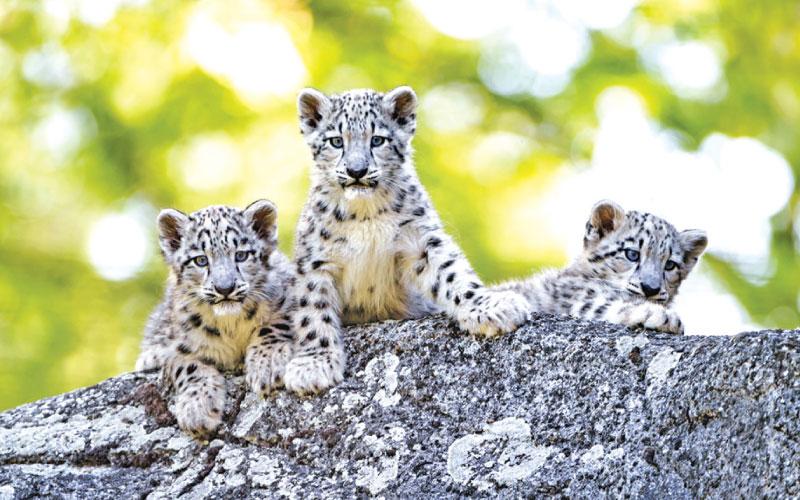
Stephen lives in the Himalayan foothills and loves to go roaming on his motor bike. But one fine day, a totally unexpected and terrifying thing happened – a snow leopard sprang at him on a mountain trail. Luckily, for Stephen, his trusty bike was able to move faster than the snow leopard and he managed to outpace the snarling creature.
The scientific name for the snow leopard is Panthera Uncia. It is also called an ounce. Some people call it the ‘ghost cat’ owing to its colouring.
Snow leopards are the smallest creatures in the group known as the Big Cats (lions, tigers, leopards, jaguars). Though the snow leopards are the smallest in this group they are still quite large. Their weight is approximately 25-55+kg (60-120lbs) and the length of their body including their long tail is between 6-7.5 feet.
The towering, rugged mountains of Central Asia is home to the snow leopard and these mountains have some of the coldest and harshest climates in the world. The snow leopard’s home range is approximately two million km2 and includes China, Bhutan, Nepal, India, Pakistan, Afghanistan, Russia, Mongolia, Kyrgystan, Tajikistan, Kazakstan and Uzbekistan. The snow leopards roam between 9,8000-17,000 feet in these rocky mountain slopes but are also found at between 3,000 – 5,400 metres above sea level in the Himalayas and at 1,000 metres above sea level in Mongolia and Russia. About 60 percent of the world’s snow leopard population has their home in China with their territory spread across over one million km2 across the far west and around the Tibetan Plateau. 
In summer, snow leopards normally live above the tree line on mountainous meadows and in rocky regions from 2,700 to 6,000 m (8,900 to 19,700 ft). In winter, they inhabit the forests at altitudes around 1,200 to 2,000 m (3,900 to 6,600 ft).
The snow leopard’s colouring is adapted to the cold and harsh climate and environment it lives in. Its gray-white coat with black rosettes blends perfectly with the rugged mountains of its homeland in Central Asia. This magnificent creature has a powerful build which helps to climb steep mountain slopes. Its hind legs enables to leap or jump six time the length of its body. It has a thick, furry coat which gives protection from the biting cold. Its long tail helps the snow leopard to be balanced and agile. The tail also wraps around it when it rests and provides much needed warmth.
It has enormous, furry paws which act like inbuilt snowshoes which help spread its body weight more evenly across snow.
The large paws also muffle the sound of its footsteps and protect its toe from the freezing cold.
 Unlike other big cats snow leopards cannot roar. While other big cats have yellow or orange eyes, snow leopards have light green or grey eyes. Snow leopards are most active at dawn and dusk.
Unlike other big cats snow leopards cannot roar. While other big cats have yellow or orange eyes, snow leopards have light green or grey eyes. Snow leopards are most active at dawn and dusk.
Oxygen is scarce in mountainous areas where the snow leopard has his home. To offset this it has powerful lungs and a large chest cavity to gather as much oxygen as it can when it inhales. Its wide nose also warms air before it enters the lungs.
The Central Asian mountains are plentiful with prey which includes blue sheep, argali wild sheep, ibex, horses, camels, marmots, pikas and hares which the snow leopard hunts.
By the time they are 2-3 years snow leopards become mature. They usually live for 15–18 years in the wild while in captivity they can live for up to 25 years. Cubs are generally born between April – June.
Today, the International Union for Conservation of Nature (IUCN), has declared the snow leopard as a vulnerable species in its Red List as it is estimated that the present global snow leopard population is less than 10,000 matured animals. Poaching, climate change, loss of habitat due to human action, conflicts with humans are among the threats faced by snow leopards.
Many organisations are working to save the snow leopard and its threatened mountain habitat. The World Wild Life Fund (WWF) IUCN, the Snow Leopard Trust, the Snow Leopard Conservancy, the Snow Leopard Network, the Cat Specialist Group, TRAFFIC and the Panthera Corporation are all involved in the battle to save the snow leopard.
